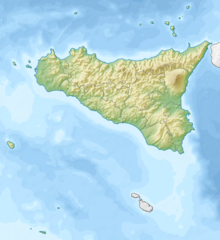Battle of Lilybaeum
| Battle of Lilybaeum | |
|---|---|
| Part of the Lilybaeum, Sicily 37°48′0.000″N 12°25′59.999″E / 37.80000000°N 12.43333306°E | |
| Result | Roman victory |
The Battle of Lilybaeum was the first clash between the navies of Carthage and Rome in 218 BC during the
Background
Carthage and the Roman Republic had peaceful, if not friendly, relations since signing the first treaty in 509 BC, which had detailed the rights of each power. Treaties were signed in 348 and 306 BC that further established the spheres of influence of each state. Carthage and Rome cooperated against
Strategic situation
The Roman Senate had declared war on Carthage after
Roman preparations
The Roman navy had been mobilized in 219 BC, fielding 220
However, Gauls of the Boii and Insubre tribes in northern Italy attacked the Roman colonies of
Consul
Punic preparations
Hannibal had dismissed his army to winter quarters after the
The Iberian contingent of the Punic navy, which numbered 50 quinqueremes (only 32 were manned) and 5 triremes, remained in Iberian waters, having shadowed Hannibal's army for some way.[6] Carthage mobilized at least 55 Quinqueremes for immediate raids on Italy.
Prelude
The Carthaginian navy struck the first blow of the war when a fleet of 20 quinqueremes, loaded with 1,000 soldiers, raided the
The battle
The Carthaginian fleet was hampered by bad weather and had to wait before commencing their operation. Although the Romans only had 20 ships present at Lilybaeum, the praetor, after receiving the warning from Hiero, provisioned his ships for a long sail and put a proper contingent of Roman legionaries on board each ship before the Carthaginian fleet appeared. He also posted lookouts along the coast to watch out for the Carthaginian ships, giving him early warning and minimizing the risk of surprise.
The Carthaginians had broken their journey at the Aegates Islands, and when they sailed for Lilybaeum on a moonlit night, they intended to make their approach coincide with the dawn. The Roman lookouts spotted them well before they reached the harbour. As the Romans sallied forth, the Carthaginians lowered their sails for battle and moved to the open sea. The Carthaginians outnumbered the Romans, but their ships were undermanned and the Romans had the advantage of containing a larger number of soldiers aboard their ships. Playing to their individual strengths, the Roman ships tried to close with the Carthaginian ships and grapple them, while the Carthaginians tried to evade the onrushing Roman ships and ram them if possible. In the melee, the Romans managed to board and capture seven Carthaginian ships and take 1,700 prisoners. The remaining Carthaginian ships managed to retreat. The Roman losses are unknown.
Aftermath
The Romans had managed to thwart the Carthaginian attempt to establish a base in Sicily. The Consul T. Sempronius Longus soon arrived with his army and fleet in Sicily. He sailed with his fleet to Malta, where he
References
- ISBN 0-304-36642-0
- ISBN 0-8061-3004-0
- ISBN 0-7509-3797-1
- ISBN 0-8061-3004-0
- ISBN 0-304-36642-0
- ISBN 0-306-81362-9
Bibliography
- Bagnall, Nigel (1990). The Punic Wars. ISBN 0-312-34214-4.
- Cottrell, Leonard (1992). Hannibal: Enemy of Rome. Da Capo Press. ISBN 0-306-80498-0.
- Lazenby, John Francis (1978). Hannibal's War. Aris & Phillips. ISBN 0-8061-3004-0.
- Goldsworthy, Adrian (2003). The Fall of Carthage. Cassel Military Paperbacks. ISBN 0-304-36642-0.
- Peddie, John (2005). Hannibal's War. Sutton Publishing Limited. ISBN 0-7509-3797-1.
- Dodge, Theodore Ayrault (1891). Hannibal. Da Capo Press. ISBN 0-306-81362-9.
Further reading
- Lancel, Serge (1997). Carthage A History. Blackwell Publishers. ISBN 1-57718-103-4.
- Warry, John (1993). Warfare in The Classical World. Salamander Books Ltd. ISBN 1-56619-463-6.
- Casson, Lionel (1981). The Ancient Mariners 2nd Edition. Princeton University Press. ISBN 0-691-01477-9.
- Lancel, Serge (1999). Hannibal. Blackwell Publishers. ISBN 0-631-21848-3.
- Baker, G. P. (1999). Hannibal. Cooper Square Press. ISBN 0-8154-1005-0.
- Casson, Lionel (1991). The Ancient Mariners. Princeton University Press. ISBN 0-691-01477-9.




